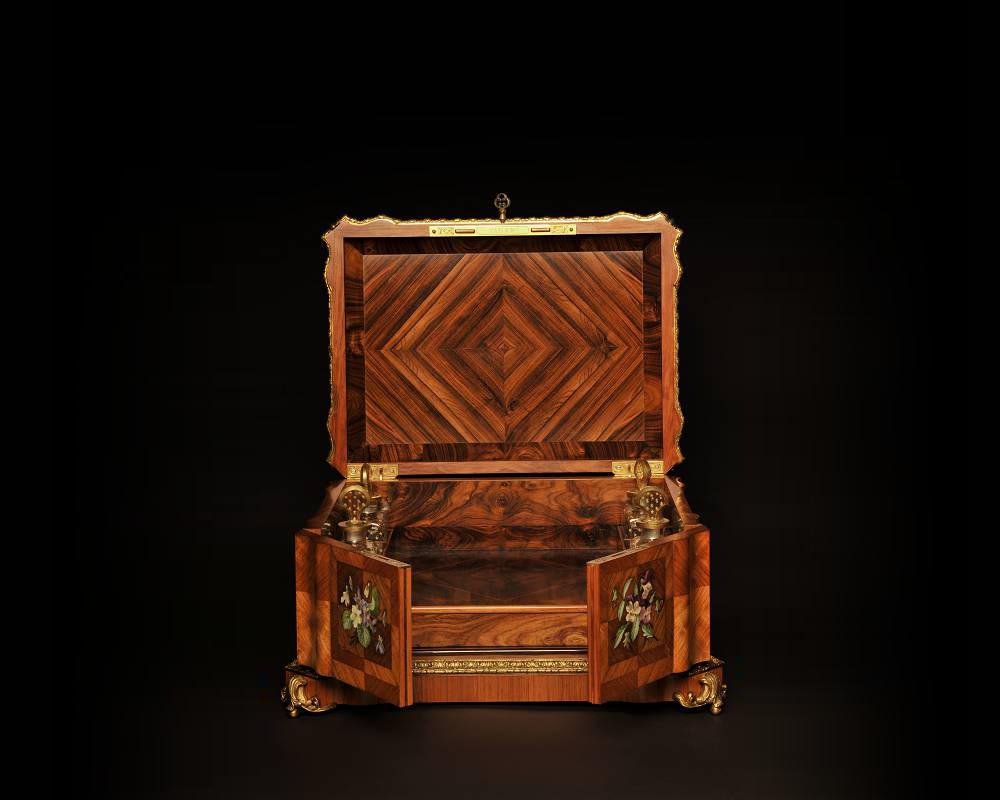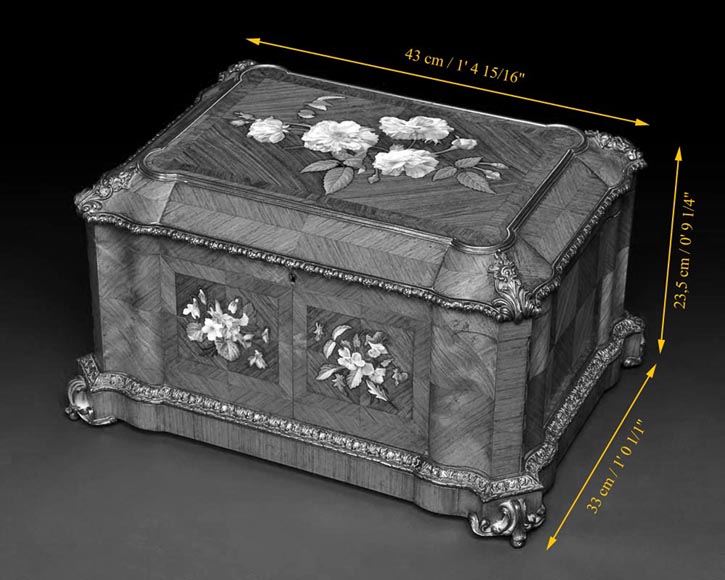Style Napoleon III / Ref.16684
Maison TAHAN and Julien-Nicolas RIVART (1802-1867) - Perfume box decorated with porcelain marquetry
Dimensions
Width 16'' ⅞ 43cm
Height 9'' ½ 24cm
Depth: 13'' 33cm
Origin:
Between 1850 and 1867.
Signed: “Tahan” on the lock
Status:
Rosewood, gilt-bronze, porcelain marquetry, crystal flowers, cushion. In very good condition.
Marc Maison and Emmanuelle Arnauld, Masterpices of Marquetry in the 19th century, Patents. Rivart, Cremer, Fourdinois, Kayser Sohn et Duvinage, Dijon, Faton, 2012, p. 45.
This elegant perfume box, signed by the Maison Tahan , is a rare example of their collaboration with an artist outside the company. Decorated with gilt-bronze ornaments and porcelain marquetry panels, this piece is a fine example of the new technique of inlaid porcelain that Julien-Nicolas Rivart patented in 1849. In this process, each piece of porcelain is used as true marquetry where each element is independent. Rivart 's patent allowed him to retain exclusivity on this type of work and he was obviously closely involved with the box's fabrication.
Rivart won awards for his porcelain marquetry on several occasions at international exhibitions, as this technique was highly esteemed for its great naturalism in reproducing flowers. In this example, the roses that decorate the lid of the box are executed in a range of elegant pastel tones that depict each petal with great precision while conveying the fragile quality of the flowers. The use of green-tinted resin for the delicate stems adds to the refinement and realistic look of the bouquet of flowers. The four small panels decorating the side panels continue the floral theme, a favorite device used by Rivart . Pansies, lilacs and rose leaves cover the surface of the wood, painted in delicate, monochrome tones of white and mauve.
This technique, patented by Rivart in 1849, was described as a "delicious process" and won immediate and unanimous praise for the charming quality of these decorations in porcelain marquetry, as well as for the originality of his technique. Rivart was critically acclaimed at the World's Fairs where he won several medals, thus leading him to further develop this type of ornamentation until his death, in 1867. For more than twenty years, Rivart was the only one to create works using this technique, a fact that explains the rarity of this type of production.
There is no signature of the painted inlaid flowers; however, it is possible to attribute the work to Pierre-Joseph Guérou , a painter who worked at the Sèvres factory in 1847 and 1848 and whose signature appears on several pieces of furniture made by Rivart , such as the jewel cabinet at the Château de Compiègne.
When looking at the delicacy and naturalism of porcelain marquetry, we too can experience the feelings described by the commentators at the International Exhibition when they enthusiastically wrote: "one cannot help but admire the graceful richness of these inlaid painted porcelain flowers" (Paris en 1855, journal de l'exposition générale…, May 27, 1855).
The origins of the Maison Tahan go back to Belgium at the beginning of the 19th century when Pierre Lambert Tahan founded a workshop that produced small tabletry objects using wood from the resort town of Spa, the small village in the Ardennes. Pierre Lambert decided to leave Spa shortly before 1806 to set up shop in the Temple area of Paris. He worked there as a cabinetmaker and also produced nécessaire boxes. In 1825, Pierre Lambert and his son, Jean Pierre Alexandre, ran two factories producing these same types of wares. In 1844, Pierre Lambert Tahan retired and left the direction of the company to his son who would completely reorganize the business by separating the factory from the shop, located at number 32 rue de la Paix. A year later, he was already known as a "Supplier to the King and Princes". In 1855, he held the title of "Supplier to the Emperor" which allows us to date this perfume box to after that time. The Court gave him a great number of commissions for bookcases, tables, pedestal tables and nécessaires. Pierre Alexandre Tahan participated in the great international exhibitions of his time. It was at the International Exhibition of 1855, in Paris, that he showed an extraordinary aviary in walnut sculpted with leaves and birds in flight.
Informations
Price: on request
Recommended for you :
Dimensions:
Width: 29
Height: 11
Depth: 21
Dimensions:
Width: 9
Height: 25
Depth: 9
Dimensions:
Height: 23
Diameter: 10
Dimensions:
Height: 10
Diameter: 9
Dimensions:
Width: 14
Height: 28
Depth: 10
Dimensions:
Width: 20
Height: 34
Depth: 15
Dimensions:
Height: 33
Depth: 16
Dimensions:
Height: 25
Diameter: 12
Dimensions:
Width: 15
Height: 38
Depth: 15
Dimensions:
Width: 11
Height: 15
Depth: 11
Dimensions:
Height: 38
Diameter: 15
Dimensions:
Height: 26
Depth: 14




















